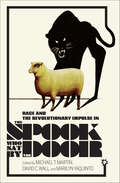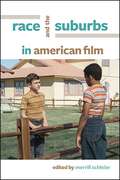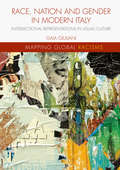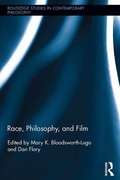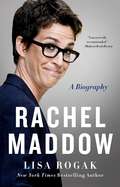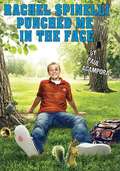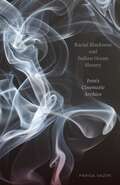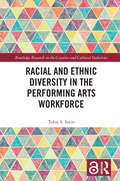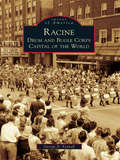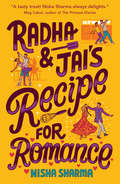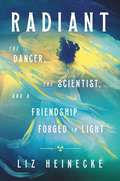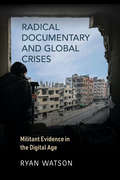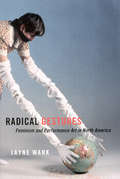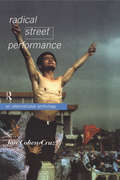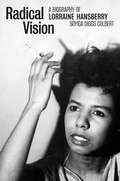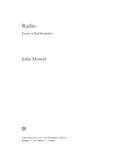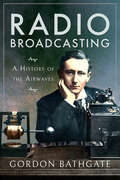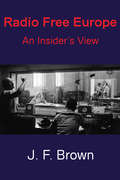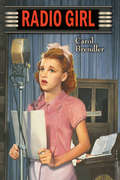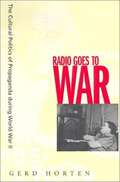- Table View
- List View
Race and the Revolutionary Impulse in The Spook Who Sat by the Door (Studies in the Cinema of the Black Diaspora)
by Michael T. Martin, David C. Wall and Marilyn YaquintoIvan Dixon's 1973 film, The Spook Who Sat by the Door, captures the intensity of social and political upheaval during a volatile period in American history. Based on Sam Greenlee's novel by the same name, the film is a searing portrayal of an American Black underclass brought to the brink of revolution. This series of critical essays situates the film in its social, political, and cinematic contexts and presents a wealth of related materials, including an extensive interview with Sam Greenlee, the original United Artists' press kit, numerous stills from the film, and the original screenplay. This fascinating examination of a revolutionary work foregrounds issues of race, class, and social inequality that continue to incite protests and drive political debate.
Race and the Suburbs in American Film (SUNY series, Horizons of Cinema)
by Merrill SchleierThis book is the first anthology to explore the connection between race and the suburbs in American cinema from the end of World War II to the present. It builds upon the explosion of interest in the suburbs in film, television, and fiction in the last fifteen years, concentrating exclusively on the relationship of race to the built environment. Suburb films began as a cycle in response to both America's changing urban geography and the re-segregation of its domestic spaces in the postwar era, which excluded African Americans, Asian Americans, and Latinx from the suburbs while buttressing whiteness. By defying traditional categories and chronologies in cinema studies, the contributors explore the myriad ways suburban spaces and racialized bodies in film mediate each other. Race and the Suburbs in American Film is a stimulating resource for considering the manner in which race is foundational to architecture and urban geography, which is reflected, promoted, and challenged in cinematic representations.
Race under Reconstruction in German Cinema
by Angelica FennerRace Under Reconstruction in German Cinema investigates postwar racial formations via a pivotal West German film by one of the most popular and prolific directors of the era. The release of Robert Stemmle's Toxi (1952) coincided with the enrolment in West German schools of the first five hundred Afro-German children fathered by African-American occupation soldiers. The didactic plot traces the ideological conflicts that arise among members of a patrician family when they encounter an Afro-German child seeking adoption, herein broaching issues of integration at a time when the American civil rights movement was gaining momentum and encountering violent resistance.Perceptions of 'Blackness' in Toxi demonstrate continuities with those prevailing in Wilhelmine Germany, but also signal the influence of American social science discourse and tropes originating in icons of American popular culture, such as Uncle Tom's Cabin, Birth of a Nation, and several Shirley Temple films. By applying a Cultural Studies approach to individual film sequences, publicity photos, and press reviews, Angelica Fenner relates West German discourses around race and integration to emerging economic and political anxieties, class antagonism, and the reinstatement of conventional gender roles.The film Toxi is now available on DVD from the DEFA Film Library.
Race, Nation and Gender in Modern Italy: Intersectional Representations In Visual Culture (Mapping Global Racisms)
by Gaia GiulianiThis book explores intersectional constructions of race and whiteness in modern and contemporary Italy. It contributes to transnational and interdisciplinary reflections on these issues through an analysis of political debates and social practices, focusing in particular on visual materials from the unification of Italy (1861) to the present day. Giuliani draws attention to rearticulations of the transnationally constructed Italian ‘colonial archive’ in Italian racialised identity-politics and cultural racisms across processes of nation building, emigration, colonial expansion, and the construction of the first post-fascist Italian society. The author considers the ‘figures of race’ peopling the Italian colonial archive as composing past and present ideas and representations of (white) Italianness and racialised/gendered Otherness. Students and scholars across a range of disciplines, including Italian studies, political philosophy, sociology, history, visual and cultural studies, race and whiteness studies and gender studies, will find this book of interest.
Race, Philosophy, and Film (Routledge Studies in Contemporary Philosophy #50)
by Mary K. Bloodsworth-Lugo Dan FloryThis collection fills a gap in the current literature in philosophy and film by focusing on the question: How would thinking in philosophy and film be transformed if race were formally incorporated moved from its margins to the center? The collection’s contributors anchor their discussions of race through considerations of specific films and television series, which serve as illustrative examples from which the essays’ theorizations are drawn. Inclusive and current in its selection of films and genres, the collection incorporates dramas, comedies, horror, and science fiction films (among other genres) into its discussions, as well as recent and popular titles of interest, such as Twilight, Avatar, Machete, True Blood, and The Matrix and The Help. The essays compel readers to think more deeply about the films they have seen and their experiences of these narratives.
Rachel Maddow: A Biography
by Lisa RogakThe first biography of the most popular anchor in cable news.Rachel Maddow has beaten the odds in a way that’s novel in today’s America: she uses her brain. In a world of banal and opinionated soundbites, she regularly crushes Sean Hannity’s ratings thanks to her deeply researched reports. And in our highly polarized world, Maddow amiably engages the staunchest conservatives, while never hesitating to expose their light-on-facts defenses. As a result, she's become the top anchor for MSNBC and a beloved representative for all that progressive America holds dear. The news that Maddow was the first publicly-out lesbian to anchor a prime-time TV news show seemed almost anticlimactic to her millions of viewers, who will be surprised and intrigued by little-known details of her life, as written by New York Times bestselling biographer Lisa Rogak. Growing up in a conservative California town – and viewing herself as a perennial outsider – helped spark an early interest in activism. After attending Stanford and Oxford, she opted for a minimum-wage job as a radio DJ in a tiny Massachusetts market while finishing her Ph.D. She planned to pursue a career as an activist, but 9/11 changed all that, so she returned to local radio where she could help listeners by "explaining stuff." A stint at Air America raised her national profile, which led to her groundbreaking MSNBC show where she dissects the news of the day with an approach found nowhere else on TV.
Rachel Spinelli Punched Me in the Face
by Paul Acampora[From the front dust Jacket flap] "As the new kid in the small town of Falls, Connecticut, Zachary Beatrice could use a friend. Thanks to Rachel Spinelli, he's about to get a whole lot more. Rachel's got a good heart, but she can be ferocious if you taunt her brother, and she's not afraid to throw a punch when necessary. For Zachary, life back in Copper Lake, Colorado, was certainly never this exciting! Now, instead of an isolated existence on the edge of town, he's in the midst of all the action, chatting with regulars at the local diner, playing the trumpet as though his life depended on it, and warding off the punches that inevitably come his way. Best of all, he's figuring out that when life punches you in the face, you just get back on up. From the author of Defining Dulcie, comes a novel about new beginnings, the power of forgiveness, and the quirky people that make life interesting." If you enjoyed this funny, story of real kids working at fitting in to their everchanging world, read Defining Dulcie by this author which is in the Bookshare collection.
Racial Blackness and Indian Ocean Slavery: Iran's Cinematic Archive
by Parisa VaziriRethinking the history of African enslavement in the western Indian Ocean through the lens of Iranian cinema From the East African and Red Sea coasts to the Persian Gulf ports of Bushihr, Kish, and Hurmuz, sailing and caravan networks supplied Iran and the surrounding regions with African slave labor from antiquity to the nineteenth century. This book reveals how Iranian cinema preserves the legacy of this vast and yet long-overlooked history that has come to be known as Indian Ocean slavery. How does a focus on blackness complicate traditional understandings of history and culture? Parisa Vaziri addresses this question by looking at residues of the Indian Ocean slave trade in Iranian films from the second half of the twentieth century. Revealing the politicized clash between commercial cinema (fīlmfārsī) and alternative filmmaking (the Iranian New Wave), she pays particular attention to the healing ritual zār, which is both an African slave descendent practice and a constitutive element of Iranian culture, as well as to cinematic sīyāh bāzī (Persian black play). Moving beyond other studies on Indian Ocean and trans-Saharan slavery, Vaziri highlights the crystallization of a singular mode of historicity within these cinematic examples—one of &“absence&” that reflects the relative dearth of archival information on the facts surrounding Indian Ocean slavery. Bringing together cinema studies, Middle East studies, Black studies, and postcolonial theory, Racial Blackness and Indian Ocean Slavery explores African enslavement in the Indian Ocean through the revelatory and little-known history of Iranian cinema. It shows that Iranian film reveals a resistance to facticity representative of the history of African enslavement in the Indian Ocean and preserves the legacy of African slavery&’s longue durée in ways that resist its overpowering erasure in the popular and historical imagination. Retail e-book files for this title are screen-reader friendly with images accompanied by short alt text and/or extended descriptions.
Racial and Ethnic Diversity in the Performing Arts Workforce (Routledge Research in the Creative and Cultural Industries)
by Tobie S. SteinRacial and Ethnic Diversity in the Performing Arts Workforce examines the systemic and institutional barriers and individual biases that continue to perpetuate a predominately White nonprofit performing arts workforce in the United States. Workforce diversity, for purposes of this book, is defined as racial and ethnic diversity among workforce participants and stakeholders in the performing arts, including employees, artists, board members, funders, donors, educators, audience, and community members. The research explicitly uncovers the sociological and psychological reasons for inequitable workforce policies and practices within the historically White nonprofit performing arts sector, and provides examples of the ways in which transformative leaders, sharing a multiplicity of cultural backgrounds, can collaboratively and collectively create and produce a culturally plural community-centered workforce in the performing arts. Chapter 1 of this book is freely available as a downloadable Open Access PDF at http://www.taylorfrancis.com under a Creative Commons Attribution-Non Commercial-No Derivatives (CC-BY-NC-ND) 4.0 license.
Racine: Drum and Bugle Corps Capital of the World
by George D. FennellMany activities become short-lived fads. Not so for the drum and bugle corps in Racine. Here, after 150 years, drum and bugle corps activity still flourishes as a proud tradition. Racine is the self-proclaimed drum corps capital of the world. Racine had six competing drum and bugle corps during the 1960s and 1970s--very impressive for a community of 90,000. In fact, it would be difficult to find a longtime resident who is unaware of this activity. Everyone in Racine either was a member of or had family or friends who were members of a drum and bugle corps.
Radha & Jai's Recipe for Romance
by Nisha SharmaTo All the Boys I Loved Before meets World of Dance in this delectable love story that combines food, dance, and a hint of drama to cook up the perfect romance.Radha is on the verge of becoming one of the greatest kathak dancers in the world . . . until a family betrayal costs her the biggest competition of her life. Now she has left her Chicago home behind to follow her stage mom to New Jersey. At the Princeton Academy of the Arts, Radha is determined to leave performing in her past and reinvent herself from scratch.Jai is captain of the Bollywood Beats dance team, ranked first in his class, and is an overachiever with no college plans. Tight family funds means medical school is a pipe dream, which is why he wants to make the most out of high school. When Radha enters his life, he realizes she's the exact ingredient he needs for a show-stopping senior year.With careful choreography, both Radha and Jai will need to face their fears (and their families) if they want a taste of a happily ever after."A delicious YA rom-com full of heart, flavor, and just enough heat." --JULIE MURPHY, New York Times bestselling author of Dumplin'"A tasty treat! Nisha Sharma always delights." --MEG CABOT, author of The Princess Diaries"A sumptuous tale of dance, food, and culture. I savored every last page!" --PINTIP DUNN, New York Times bestselling author
Radiant: The Dancer, The Scientist, and a Friendship Forged in Light
by Liz HeineckePart hidden history, part love letter to creative innovation, this is the true story of an unlikely friendship between a dancer, Loie Fuller, and a scientist, Marie Curie, brought together by an illuminating discovery. At the turn of the century, Paris was a hotbed of creativity. Technology boomed, delivering to the world electric light, the automobile, and new ways to treat disease, while imagination blossomed, creating Art Nouveau, motion pictures, and modernist literature. A pivotal figure during this time, yet largely forgotten today, Loie Fuller was an American performance artist who became a living symbol of the Art Nouveau movement with her hypnotic dances and stunning theatrical effects. Credited today as the pioneer of modern dance, she was perennially broke, never took no for an answer, spent most of her life with a female partner, and never questioned her drive. She was a visionary, a renegade, and a loyal friend. In the early 1900s, she heard about Marie Curie's discovery of a glowing blue element and dreamed of using it to dazzle audiences on stage. While Loie's dream wouldn't be realized, her connection with Marie and their shared fascination with radium endured. Radiant is the true story of Marie Curie and Loie Fuller, two revolutionary women drawn together at the dawn of a new era by a singular discovery, and the lifelong friendship that grew out of their shared passion for enlightenment.
Radical Documentary and Global Crises: Militant Evidence in the Digital Age
by Ryan WatsonWhen independent filmmakers, activists, and amateurs document the struggle for rights, representation, and revolution, they instrumentalize images by advocating for a particular outcome. Ryan Watson calls this "militant evidence."In Radical Documentary and Global Crises, Watson centers the discussion on extreme conflict, such as the Iraq War, the occupation of Palestine, the war in Syria, mass incarceration in the United States, and child soldier conscription in the Congo. Under these conditions, artists and activists aspire to document, archive, witness, and testify. The result is a set of practices that turn documentary media toward a commitment to feature and privilege the media made by the people living through the terror. This footage is then combined with new digitally archived images, stories, and testimonials to impact specific social and political situations. Radical Documentary and Global Crises re-orients definitions of what a documentary is, how it functions, how it circulates, and how its effect is measured, arguing that militant evidence has the power to expose, to amass, and to adjudicate.
Radical Doubt: The Joker System, after Boal
by Mady SchutzmanRadical Doubt investigates ethical play across a spectrum of performances, on and off the stage. In witty, recursive, personal, and propulsive prose, Mady Schutzman elaborates on the Joker System, conceived by Augusto Boal, best known for Theatre of the Oppressed. The Joker System is a collaborative approach to representing social dilemmas through a rare fusion of destabilizing ambiguity and journalistic rigor. Schutzman models the Joker System while expanding well beyond the theatrical. In polyphonic compositions that perform their own philosophy, she uncovers illuminating links between calculus and conjuring, kōans and resistance, humor and witnessing, complexity theory and sorely needed new practices of living in our divisive times. These life practices rely upon crafty and circuitous strategies to deliver their subversive punch. Jok(er)ing matters, Schutzman insists. When communities fragment and identities fixate, enter the trickster! Sonja KuftinecTheatre Arts and Dance, University of Minnesota
Radical Gestures
by Jayne WarkWark brings together a wide range of artists, including Lisa Steele, Martha Rosler, Lynda Benglis, Gillian Collyer, Margaret Dragu, and Sylvie Tourangeau, and provides detailed readings and viewings of individual pieces, many of which have not been studied in detail before. She reassesses assumptions about the generational and thematic characteristics of feminist art, placing feminist performance within the wider context of minimalism, conceptualism, land art, and happenings
Radical Gestures: Feminism and Performance Art in North America
by Jayne WarkWark brings together a wide range of artists, including Lisa Steele, Martha Rosler, Lynda Benglis, Gillian Collyer, Margaret Dragu, and Sylvie Tourangeau, and provides detailed readings and viewings of individual pieces, many of which have not been studied in detail before. She reassesses assumptions about the generational and thematic characteristics of feminist art, placing feminist performance within the wider context of minimalism, conceptualism, land art, and happenings
Radical Love: Learning to Accept Yourself and Others
by Zachary LeviI'm not an expert, therapist, pastor, teacher, or monk. I am merely a person going through my own mental and emotional health journey, hoping that I can pass on some of the wisdom and tools that I'd been blessed enough to learn along the way. And I truly believe that if we can help heal the hearts and minds of everyone on earth, we will solve every other problem known to man in the process. -- Zachary LeviRadical Love is the debut memoir from Zachary Levi (Shazam!, American Underdog, The Marvelous Mrs. Maisel, Chuck), which shares his emotional journey through a lifetime of crippling anxiety and depression to find joy, gratitude, and ultimate purpose. Facing the scars of childhood trauma and the voices in his head that told him he would never be enough, Zac recounts the raw yet honest behind-the-scenes story of his family life, career successes, and the personal disappointments that led him to rock bottom and landed him in a therapy center, where he learned to address the underlying issues that preceded his downward spiral.Radical Love combines witty, touching, and powerful commentary with relatable illustrations to help you on your own path toward mental wellness. With vulnerability and humor, Zac relates the valuable lessons and insights he&’s learned so that you can rise from the ashes of trauma and pursue a meaningful life of gratitude.
Radical Street Performance: An International Anthology
by Jan Cohen-CruzRadical Street Performance is the first volume to collect together the fascinating array of writings by activists, directors, performers, critics, scholars and journalists who have documented street theatre around the world. More than thirty essays explore the myriad forms this most public of performances can take: * agit-prop * invisible theatre * demonstrations and rallies * direct action * puppetry * parades and pageants * performance art * guerrilla theatre * circuses These essays look at performaces in Europe, Africa, China, India and both the Americas. They describe engagement with issues as diverse as abortion, colonialism, the environment and homophobia, to name only a few. Introduced by editor Jan Cohen-Cruz, the essays are organized into thematic sections: Agitating; Witnessing; Involving; Imagining; and Popularizing. Radical Street Performance is an inspiring testimony to this international performance phenomenon, and an invaluable record of a form of theatre which continues to flourish in a televisual age.
Radical Vision: A Biography of Lorraine Hansberry
by Soyica Diggs ColbertA &“loving, lavishly detailed&” (New York Times) and captivating portrait of Lorraine Hansberry&’s life, art, and political activism—one of O Magazine's best books of April 2021&“Hits the mark as a fresh and timely portrait of an influential playwright.&”—Publishers Weekly In this first scholarly biography of Lorraine Hansberry, Soyica Diggs Colbert narrates a life at the intersection of art and politics, arguing that for Hansberry the theater operated as a rehearsal room for her political and intellectual work. Celebrated for her play A Raisin in the Sun, Hansberry was also the author of innovative journalism and of plays touching on slavery, interracial communities, and Black freedom movements. Hansberry was deeply involved in the Black freedom struggle during the Cold War and in the early civil rights movement, and here Colbert shows us an artist&’s life with the background of the Greenwich Village art scene in the 1960s, the homophile movement, Black diasporic freedom movements, and third-wave feminism. Drawing from Hansberry&’s papers, speeches, and interviews, this book provides a new point of entry in the history of Black radicalism, and a new perspective on Black women in mid‑twentieth‑century political movements.
Radio
by John MowittIn a wide-ranging, cross-cultural, and transhistorical assessment, John Mowitt examines radio's central place in the history of twentieth-century critical theory. A communication apparatus that was a founding technology of twentieth-century mass culture, radio drew the attention of theoretical and philosophical writers such as Jean-Paul Sartre, Walter Benjamin, Jacques Lacan, and Frantz Fanon, who used it as a means to disseminate their ideas. For others, such as Martin Heidegger, Theodor Adorno, and Raymond Williams, radio served as an object of urgent reflection. Mowitt considers how the radio came to matter, especially politically, to phenomenology, existentialism, Hegelian Marxism, anticolonialism, psychoanalysis, and cultural studies. The first systematic examination of the relationship between philosophy and radio, this provocative work also offers a fresh perspective on the role this technology plays today.
Radio Broadcasting: A History of the Airwaves
by Gordon BathgateAn in-depth look at a century of radio history—and its continuing relevance in a radically changed world.A century after Marconi’s experimental transmissions, this book examines the history of radio and traces its development from theories advanced by James Clerk Maxwell and Heinrich Hertz to the first practical demonstrations by Guglielmo Marconi. It looks back to the pioneering broadcasts of the BBC, examines the development of broadcast networks in North America and around the world, and spotlights radio’s role in the Second World War.The book also features the radio programs and radio personalities that made a considerable impact on listeners during the “Golden Era.” It examines how radio, faced by competition from television, adapted and survived. Indeed, radio has continued to thrive despite increased competition from mobile phones, computers, and other technological developments. Radio Broadcasting looks ahead and speculates on how radio will fare in a multi-platform future.
Radio Empire: The BBC’s Eastern Service and the Emergence of the Global Anglophone Novel (Modernist Latitudes)
by Daniel Ryan MorseInitially created to counteract broadcasts from Nazi Germany, the BBC’s Eastern Service became a cauldron of global modernism and an unlikely nexus of artistic exchange. Directed at an educated Indian audience, its programming provided remarkable moments: Listeners in India heard James Joyce reading from Finnegans Wake on the eve of independence, as well as the literary criticism of E. M. Forster and the works of Indian writers living in London.In Radio Empire, Daniel Ryan Morse demonstrates the significance of the Eastern Service for global Anglophone literature and literary broadcasting. He traces how modernist writers used radio to experiment with form and introduce postcolonial literature to global audiences. While innovative authors consciously sought to incorporate radio’s formal features into the novel, literature also exerted a reciprocal and profound influence on twentieth-century broadcasting. Reading Joyce and Forster alongside Attia Hosain, Mulk Raj Anand, and Venu Chitale, Morse demonstrates how the need to appeal to listeners at the edges of the empire pushed the boundaries of literary work in London, inspired high-cultural broadcasting in England, and formed an invisible but influential global network.Adding a transnational perspective to scholarship on radio modernism, Radio Empire demonstrates how the history of broadcasting outside of Western Europe offers a new understanding of the relationship between colonial center and periphery.
Radio Free Europe: An Insider's View
by J. F. BrownThe story of Radio Free Europe’s role during the Cold War, as recounted by veteran RFE official J. F. Brown, who served as director from 1978 to 1983.Jim Brown had written about Eastern Europe from RFE, but never about RFE?until he wrote this book. He conveys his understanding of how Radio Free Europe functioned as a decentralized organization that empowered exiles, while also conveying what it, and they, could?and could not?offer East European listeners. Jim Brown’s explanations of the function of the central news department as an internal news agency, of discussions with and trust of exile broadcast chiefs, of RFE’s cautious approach to broadcasting to Poland under martial law after 1981?to cite only three examples from the book?illuminate the editorial policies and internal relationships that made RFE a success. His portraits of key personalities over the years help us understand that RFE was not just an institution; it was a unique multinational group of people. (From the Foreword by A. Ross Johnson).Praise for Radio Free Europe: An Insider’s View“The historical analysis Brown brings is extremely valuable and adds the insight of a first-rate analyst to such topics as the contrast between how RFE handled the Hungarian and Polish events of the 1950s, the “Czech spring” in 1968, the Gomulka period in Poland, the developing independence of Ceausescu’s Romania, etc. All are given perceptive treatment.” —Eugene R. Parta, co-author of Cold War Broadcasting: Impact on the Soviet Union and Eastern Europe“I know of no other books on RFE by an insider who had so much experience with the Radios and how they were operated. [It is] very well written, well organized, and a fascinating read.” —Yale Richmond, cultural affairs officer, U.S. Foreign Service (ret.), author of Practicing Public Diplomacy: A Cold War Odyssey
Radio Girl
by Carol BrendlerCan a girl from a middle-class Irish Catholic family living in Newark, New Jersey, in 1938 find fame and fortune (or even a job) as a radio star? Tune in to this unforgettable historical novel to find out. Poignant, often hilarious, it's the story of a family in crisis. Just as artful deception, smoke and mirrors characterize radio reality, so lies, secrets, and profound misunderstandings mark fourteen-year-old Cece Maloney's life: her secret job at a radio station, a cheating father, an aunt who may be romantically involved with the parish priest, a boy-crazed best friend, and a ham radio operator and would-be soldier both lying to their parents. The worlds collide on the night of Orson Welles's famous "The War of the Worlds" broadcast. As thousands flee in panic from the alleged Martian invasion, Cece must expose the truth about the radio hoax and confront the truth about her own and her family's dishonesty.
Radio Goes to War: The Cultural Politics of Propaganda During World War II
by Gerd HortenAs a comprehensive and in-depth look at the role of domestic radio in the United States during the Second World War, this study demonstrates how radio broadcasting played a crucial role both in government propaganda and within the context of the broader cultural and political transformations of wartime America and argues that no medium merged entertainment, propaganda, and advertising more effectively than radio.
